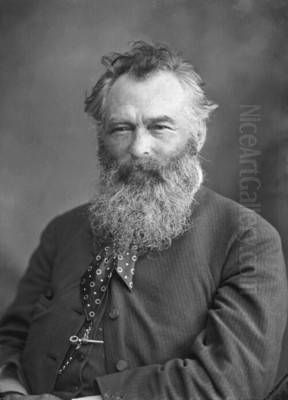
Ivan Ivanovich Shishkin stands as a monumental figure in the history of Russian art, celebrated primarily for his profound and meticulously detailed depictions of the Russian landscape. Living from 1832 to 1898, Shishkin dedicated his artistic life to capturing the essence, grandeur, and intricate beauty of his homeland's forests, fields, and natural vistas. His work is synonymous with the peak of Russian Realist landscape painting in the 19th century, and his influence resonates through generations of artists. As a leading member of the influential Peredvizhniki (Wanderers) movement, Shishkin not only achieved personal artistic renown but also played a crucial role in shaping the direction of Russian national art.
Early Life and Formative Years
Ivan Ivanovich Shishkin was born on January 25, 1832, in the small town of Yelabuga, located in the Vyatka Governorate (modern-day Republic of Tatarstan), Russia. He hailed from an old merchant family. His father, Ivan Vasilyevich Shishkin, was not only a grain merchant but also an amateur archaeologist and local historian, a passion that likely instilled in the young Ivan a deep appreciation for his native region and its history. This connection to his roots would become a cornerstone of his artistic identity.
Recognizing his son's burgeoning talent and inclination towards art, Shishkin's father supported his decision to pursue artistic training, a path less common for someone of a merchant background at the time. Shishkin first enrolled at the Moscow School of Painting, Sculpture and Architecture, where he studied from 1852 to 1856. Here, he received foundational training, honing his skills in drawing and painting, already showing a preference for landscape subjects. His dedication and talent were evident early on.
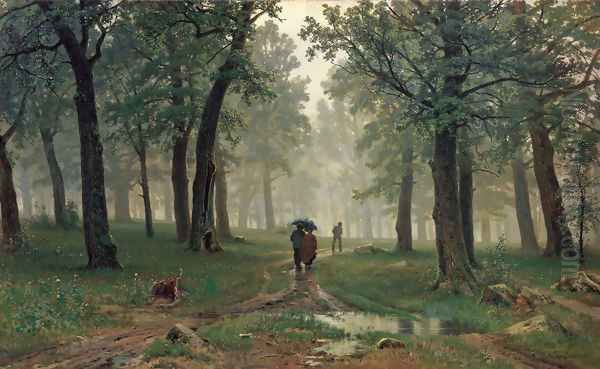
Seeking more advanced instruction, Shishkin moved to the cultural heart of the Russian Empire, St. Petersburg, in 1856. He entered the prestigious Imperial Academy of Arts, studying under Professor Sokrat Vorobiev, a noted landscape painter himself. However, sources also mention the influence of Romanticist mentors like Apollon Mokritsky during his academic years. The Academy provided rigorous training, emphasizing classical techniques and composition, but Shishkin was increasingly drawn to direct observation of nature. During his time at the Academy, he made frequent sketching trips, notably to the island of Valaam on Lake Ladoga, known for its rugged, pristine nature and ancient monastery. These excursions were crucial, allowing him to study trees, rocks, water, and light effects firsthand, developing the empirical basis for his later masterpieces.
European Travels and Academic Recognition
Shishkin excelled at the Imperial Academy, winning numerous awards, including a major gold medal which granted him a scholarship for postgraduate study abroad. From 1862 to 1865, he traveled extensively in Europe, primarily in Germany and Switzerland. This period was vital for broadening his artistic horizons and refining his technique, exposing him to contemporary European art movements, particularly the Düsseldorf School of painting in Germany.
In Switzerland, he sought out the mentorship of the landscape and animal painter Rudolf Koller in Zurich, known for his realistic depictions. In Germany, particularly in Düsseldorf, Shishkin associated with several artists, including the prominent landscape painters Andreas Achenbach and Oswald Achenbach, and reportedly worked in the studio of the animal and genre painter Adolf Schrödter. He spent considerable time sketching in locations like the Teutoburg Forest, absorbing the techniques of detailed realism prevalent in the Düsseldorf School but always adapting them to his unique vision and focus on the specific character of nature. His work from this period, such as View in the Vicinity of Düsseldorf (1865), earned him further recognition.
Upon his return to Russia in 1865, Shishkin was quickly recognized for his matured skills and unique approach to landscape. He was elected as an Academician by the Imperial Academy of Arts, a significant honor confirming his status within the official art establishment. Later, in 1873, the Academy appointed him as a Professor of landscape painting, a position he held, albeit with interruptions, until near the end of his life. He headed the landscape workshop, mentoring a new generation of Russian painters.
The Peredvizhniki Movement and Shishkin's Role
Despite his ties to the Academy, Shishkin became a founding and active member of the Society for Travelling Art Exhibitions (Tovarishchestvo peredvizhnykh khudozhestvennykh vystavok), better known as the Peredvizhniki or Wanderers, established in 1870. This group represented a significant break from the conservative constraints of the Imperial Academy. The Peredvizhniki advocated for Realism, sought to make art accessible to a wider public by organizing travelling exhibitions across Russia, and often imbued their works with social commentary and a deep sense of national identity.
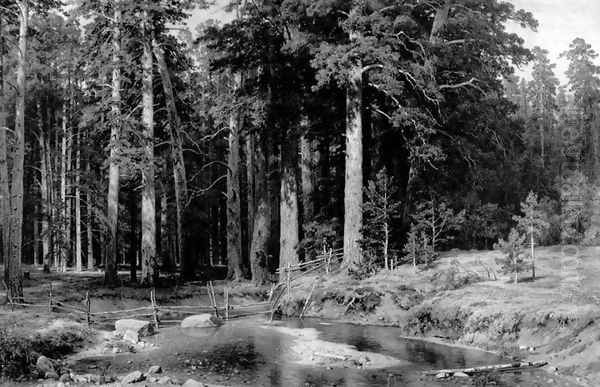
Shishkin found a natural home within the Peredvizhniki. His commitment to depicting the Russian landscape with unvarnished truthfulness aligned perfectly with the movement's Realist principles. He shared close friendships and artistic dialogues with other leading members, including the ideological leader Ivan Kramskoi, the genre painter Vasily Perov, and fellow landscape artists like Alexei Savrasov and Arkhip Kuindzhi. Kramskoi, in particular, held Shishkin in high esteem, famously painting a striking portrait of him in 1873, capturing the painter's rugged intensity amidst nature.
Shishkin's landscapes, while often devoid of overt social narratives, resonated with the Peredvizhniki's aim to reflect Russian life and spirit. His depictions of the vast, powerful, and sometimes harsh Russian nature were seen as embodying the national soul. He regularly participated in the Wanderers' exhibitions, and his works were consistently among the most popular and critically acclaimed, solidifying his reputation as the preeminent painter of the Russian forest. His involvement underscored the idea that landscape painting could be as significant and meaningful as historical or genre painting in expressing national consciousness.
Artistic Style and Technique: The "Poet of the Forest"
Ivan Shishkin's artistic style is characterized by its unwavering commitment to Realism, combined with a profound, almost spiritual connection to the natural world. He possessed an extraordinary ability to render the intricacies of nature with scientific precision, yet his works transcend mere photographic accuracy, conveying a deep sense of poetry, monumentality, and the enduring power of the Russian land.
His technical mastery was exceptional. Shishkin was a superb draftsman, and his numerous preparatory sketches and drawings reveal a meticulous study of botanical forms. He understood the structure of trees – the specific textures of bark, the branching patterns, the delicate tracery of leaves – like few other artists. This detailed knowledge formed the bedrock of his oil paintings. He applied paint with careful, controlled brushstrokes, building up textures and capturing the subtle interplay of light and shadow filtering through dense foliage or illuminating open fields.
Shishkin is often called the "poet of the forest" or the "Tsar of the Forest," titles reflecting his unparalleled ability to depict woodland scenes. He painted forests in all seasons and times of day, capturing the cool dampness of a rainy oak grove, the bright sunlight dappling pine trees, the solemn stillness of a winter wood, and the golden light of late summer across vast fields. His compositions often possess an epic quality, emphasizing the scale and permanence of nature. He favored panoramic views but was equally adept at intimate forest interiors, drawing the viewer into the scene.
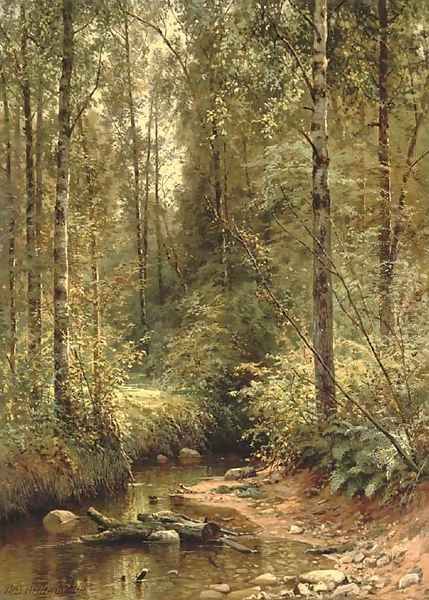
Beyond oil painting, Shishkin was also a master etcher and printmaker. He produced numerous etchings throughout his career, exploring the expressive possibilities of line and tone in black and white. These prints, often depicting similar forest and landscape motifs as his paintings, demonstrate his versatility and his consistent dedication to capturing the essence of nature through rigorous observation and technical skill. Works like the etching album Forest Song showcase this aspect of his oeuvre.
Major Works and Enduring Themes
Shishkin's prolific career yielded numerous masterpieces that have become icons of Russian art. Among his most celebrated works is Morning in a Pine Forest (1889). This painting, famous for its depiction of bear cubs playing on a fallen tree in a misty, sunlit forest, is widely beloved. Interestingly, while the landscape is entirely Shishkin's, the bears were added by his friend, the genre painter Konstantin Savitsky. Although Savitsky's signature was later removed (reportedly at the insistence of the collector Pavel Tretyakov, who felt the work's conception was wholly Shishkin's), the collaboration highlights the collegial atmosphere among the Peredvizhniki. The painting perfectly captures the wild, untouched beauty Shishkin revered.
Another seminal work is Rye (1878). This expansive panorama depicts a vast field of ripening rye under a dramatic sky, bisected by a country road along which mighty pine trees stand like sentinels. The painting is often interpreted as an epic hymn to the fertility and expanse of the Russian land, symbolizing the nation's strength and endurance. The meticulous rendering of the rye stalks and the towering pines showcases Shishkin's signature attention to detail.
Oak Grove (1887) and Rain in an Oak Forest (1891) demonstrate his mastery in depicting specific types of trees and atmospheric conditions. These works convey the powerful presence of ancient oaks and the tangible feeling of moisture and cool air in the forest. Mast Tree Grove (1898), one of his later works, presents a monumental view of towering pines, emphasizing their verticality and the cathedral-like quality of the old-growth forest.
Other significant paintings include Midday. Near Moscow (1869), Felling Trees (1867), Pines Lit by the Sun (1886), Forest Stream, and In the Wild North (1891), the latter inspired by a poem by Mikhail Lermontov. His final, unfinished painting, Forest Kingdom (1898), on which he was reportedly working the day he died, serves as a poignant testament to his lifelong dedication to the forest theme. Across these works, recurring themes emerge: the majesty and permanence of nature, the forest as both a physical reality and a symbolic space, and the deep connection between the Russian people and their native landscape.
Personal Life, Character, and Anecdotes
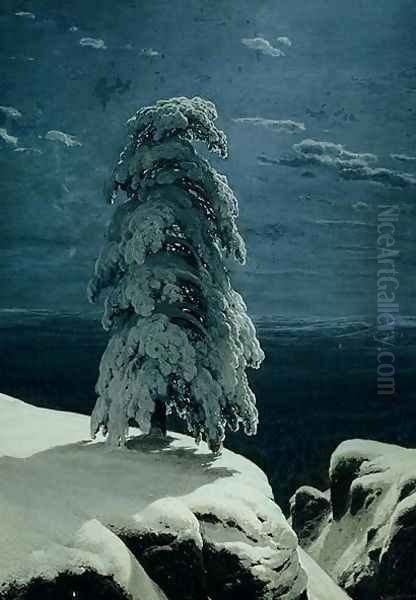
Despite his immense artistic success, Shishkin's personal life was marked by considerable tragedy. He married twice, first to Evgenia Vasilyeva (sister of fellow landscape painter Fyodor Vasilyev) in 1868, and later to his former pupil Olga Lagoda in 1880. Both wives died young, as did several of his children. These profound losses undoubtedly affected him deeply, yet he continued to immerse himself in his work, perhaps finding solace and stability in the enduring presence of nature.
Contemporaries described Shishkin as a man of imposing physical presence, somewhat reserved and serious in demeanor, yet deeply passionate about his art. His student nickname, "the bear," mentioned in anecdotes, might reflect a certain social awkwardness or gruffness, particularly in his youth. However, he was highly respected by his peers for his integrity, diligence, and unwavering artistic principles. Ivan Kramskoi’s portrait captures this sense of a strong, grounded individual deeply connected to the earth.
An anecdote involving Tsar Alexander III highlights Shishkin's renown. During an exhibition, the Tsar, impressed by Shishkin's powerful forest scenes, reportedly called him the "Tsar of the Forest." This imperial acknowledgment underscores the national significance his art had attained. Another popular story relates to the Morning in a Pine Forest painting, which became so iconic that a variation of it was famously used on the wrapper of "Mishka Kosolapy" (Clumsy Bear) chocolates, cementing its place in Russian popular culture.
Towards the end of his life, Shishkin showed an interest in the developing technology of photography, exploring its potential as an aid for capturing natural details, though he never fully integrated it into his artistic process. He remained dedicated to painting until the very end, dying suddenly on March 20, 1898, while working at his easel in his St. Petersburg studio on the painting Forest Kingdom.
Legacy and Influence
Ivan Shishkin's legacy is immense and multifaceted. He is universally regarded as one of the greatest landscape painters in Russian history, a master whose work defined the possibilities of Realism in depicting the national landscape. His paintings offered a vision of Russia that was both scientifically accurate and deeply poetic, capturing the unique character of its forests and fields with unparalleled skill and empathy.
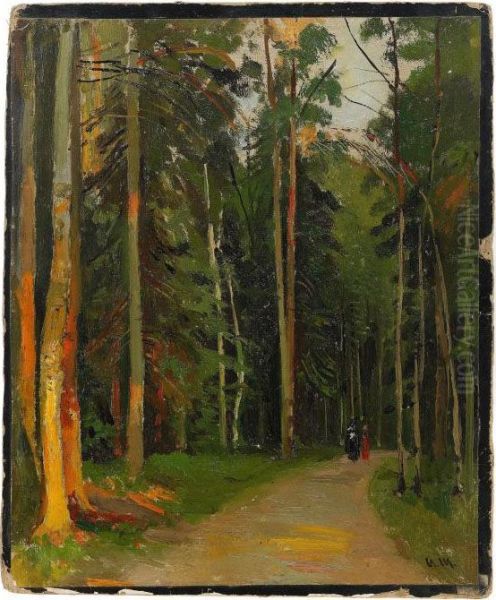
As a key figure in the Peredvizhniki movement, he helped elevate landscape painting to a position of national importance, demonstrating its capacity to express profound ideas about identity, nature, and the human spirit. His influence extended to numerous contemporaries and subsequent generations of Russian artists, including notable landscape painters like Isaac Levitan and Vasily Polenov, who built upon the foundations laid by Shishkin and other Peredvizhniki masters, albeit often moving towards more lyrical or atmospheric interpretations (like Levitan's "mood landscapes").
Today, Shishkin's works are treasured holdings in Russia's most important museums, primarily the State Tretyakov Gallery in Moscow and the State Russian Museum in St. Petersburg. Significant works can also be found in regional museums across Russia and in collections in neighboring countries, such as the National Art Museum of Ukraine in Kyiv. His former home in Yelabuga is now the Ivan Shishkin Memorial House Museum, dedicated to his life and work. His paintings remain incredibly popular, reproduced widely and cherished as quintessential representations of the Russian soul embodied in its natural landscapes.
Conclusion
Ivan Shishkin remains an enduring giant of Russian art. Through his meticulous technique, profound understanding of nature, and unwavering dedication, he created a powerful and comprehensive portrait of the Russian landscape, particularly its majestic forests. His work transcends mere representation; it is an epic celebration of the natural world, imbued with a sense of permanence, grandeur, and deep national feeling. As a leading Realist and a pillar of the Peredvizhniki movement, Shishkin not only captured the beauty of his homeland but also helped shape the very identity of Russian art in the 19th century. His legacy as the "poet of the forest" continues to inspire awe and admiration, securing his place among the world's great landscape masters.